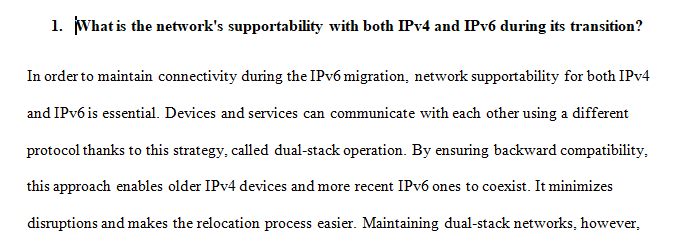Transitioning to IPv6
After re-reading the chapters and conducting additional research, you should be able to list the advantages of switching to IPv6, including the benefits of auto-configuration, better traffic prioritization and delivery assurance, better inherent security, and a virtually endless supply of IP addresses. On the other hand, transitioning to IPv6 is not always seamless. Therefore, in 750–1,000 words, address the following:
- What is the network’s supportability with both IPv4 and IPv6 during its transition?
- How will you ensure that all of the network’s applications and TCP/IP services also support IPv6?
- How will you coordinate with other organizations with which the networks connect to determine how to handle their IPv4 or IPv6 traffic?
- How will you devise a new addressing approach for the network?
- How will you handle networking hardware compatibility and addressing?
- How will you handle outward-facing application compatibility and addressing?
- What tools are available to analyze network traffic if a compatibility issue arises?
APA style is not required, but solid academic writing is expected.
This assignment uses a rubric. Please review the rubric prior to beginning the assignment to become familiar with the expectations for successful completion.
You are required to submit this assignment to LopesWrite. A link to the LopesWrite technical support articles is located in Class Resources if you need assistance.
Answer Preview: Transitioning to IPv6

